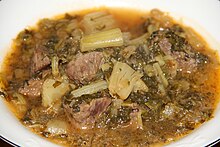Khoresh
| Type | Stew |
|---|---|
| Place of origin | Iran |
| Serving temperature | . |
| Main ingredients | Meat, Vegetables, Spices |


Khoresh Template:Lang-fa is a generic term for Persian stew dishes. The word is a verbal noun of the verb xordan (Template:Lang-fa) "to eat" and literally means "meal". The word is often misspellt Khoresht (Template:Lang-fa) in writing, which is attributable to linguistic hypercorrection. An alternative, although rare spelling, is Khorisht.
It generally refers to different stews in the Persian cuisine, and is typically served beside polo (rice). In Persian cuisines there are many different Khoresh with many unique ingredients. Vegetarian Koreshs are not uncommon. Iranian stews use liberal amounts of saffron to give a distinctive and fragrant taste. The most popular Khoreshs are Khoresh Gheymeh, Khoresh Ghormeh Sabzi and Khoresh Fesenjaan. These stews feature in Mesopotamian cuisine also.
Varieties
- Khoresh Bādenjān (Aubergine Stew): including aubergines, boned leg of lamb or stewed beef or chicken, onions, turmeric, tomato paste and medium tomatoes
- Khoresh Bādenjān Lapeh (Aubergine and Yellow Split Pea Stew): same as previous with addition of yellow split peas and Advieh
- Khoresh Bāmieh (Okra Tomato Stew): Stewing lamb or beef, okra, potatoes, onions, fresh lime juice and tomato paste
- Khoresh Bāmieh Lapeh (Okra and Yellow Split Pea Stew): same as previous with addition of yellow split peas and Advieh
- Khoresh Beh (Quince Stew): chunks of lamb are stewed with slices or cubes of tart quince, and yellow split peas; this dish is always served with rice.[1]
- Khoresh Esfenaj-o ālu (Prune and Spinach Stew)
- Khoresh Fesenjān or Fesenjun (Pomegranate Stew) including duck or chicken or beef meatballs, ground walnuts, onions, pomegranate juice, pomegranate paste, sugar
- Khoresh Havij (Carrot Stew)
- Khoresh Kadu (Zucchini Stew): pan-fried whole or long-cut sliced zucchini, stewed lamb, beef or chicken, onions, tomato paste and whole or split pan-fried tomatoes
- Khoresh Qārch (Mushroom Stew)
- Khoresh Gheimeh (Split-pea Lamb Stew) including Stewing lamb or beef, Split-peas, onions, potatoes, tomato paste and dried limes
- Khoresh Ghormeh Sabzi (Fresh Herb and Lamb Stew) including Red kidney or black-eyed beans, Fresh fenugreek, parsley, coriander or parsley, spring onions or leeks, boned leg of lamb, onion and dried limes
- Khoresh Kangar
- Khoresh Karafs (Celery Beef Stew) including lamb or beef, celery, onions, fresh lime juice, mint, and parsley
- Khoresh Lubia-Sabz (French Bean Stew)
- Khoresh Reevaas (Rhubarb Stew)
Salt, pepper, and oil also are also used in these dishes.
See also
References
- ^ Ramazani, Nesta. "Uses of the Fruit in Cooking". Encyclopedia Iranica. Retrieved 2008-10-11.
